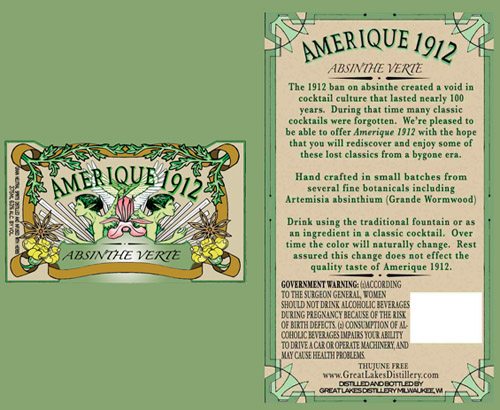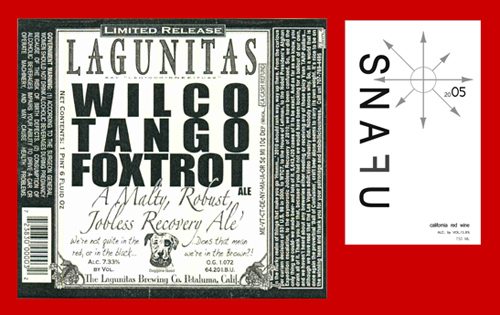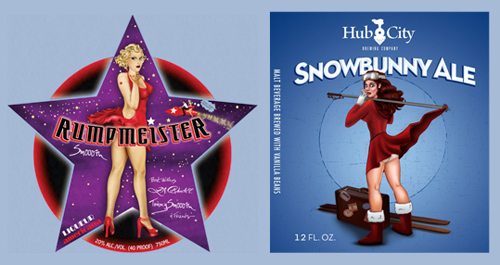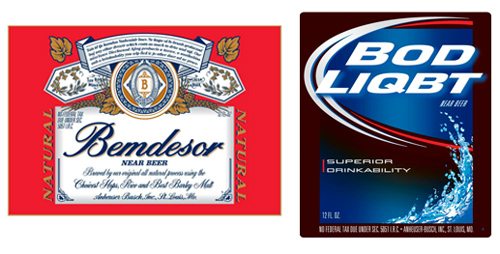This absinthe label does a good job explaining the recent history about absinthe. It explains that absinthe was banned from 1912 until almost 100 years later. More of the story about the legalization of absinthe is here, and the the first 20 or so products approved for US sale are listed here.
Amerique 1912 is distilled by Great Lakes Distillery in Milwaukee, Wisconsin. It is also one of the few absinthes that states “thujone free” on the bottle.
Lithuanian Beer Goggles
This is Before-After Beer, produced by Rinkuskiai beer company of Lithuania. It is imported by Aiko Importers of Mount Pleasant, South Carolina. With a little help from Rinkuskiai, the old man metamorphosizes into the young woman, providing further evidence for this and this theory.
Good Flags and Bad Flags
In many situations, TTB will not allow national flags, and especially not the US flag. The regulations support this. So the above labels seem to be noteworthy exceptions.
Maize Valley Winery’s Redneck Red wine shows The American Flag on the main label, alongside The Confederate Flag.
In the second example, The American Flag appears with the Military Flag of Japan. The wine is made by D’Vine Wine of Fredricksburg, Texas. A notable instance where TTB did not allow the US flag is on this New Hampshire beer.
Military and Other Slang
We find no FUBAR approvals to date, but here we have WTF ale from Lagunitas, and SNAFU wine from Cartlidge & Browne.
Both make liberal use of military slang. Lagunitas does so to express their dismay and confusion about the current state of world affairs. Tango and Foxtrot are well established as the military alphabet codes for T and F. Wilco famously used these codes on a 2002 album, but Whiskey, rather than Wilco, is the correct code for W. Perhaps the Petaluma, California brewer believed TTB would not allow the term “whiskey” on a malt beverage label. Or perhaps they are big Wilco fans. Or perhaps they are just very confused, further to the freewheeling text on the label (tieing in Bush v. Gore, adult videos, and imbibilisciousness).
SNAFU, apart from the acronym, is California red wine bottled by Cartlidge & Browne in American Canyon, California. It claims to be the first wine to provide tasting notes via text message.
Short Red Dresses
As to risqué alcohol beverage labels, there is no end in sight.
On the left is Rumpmeister Liqueur, made by Colorado Pure Distilling, in Lakewood, Colorado.
On the right is Snowbunny Ale, made by Hub City Brewing Company, in Stanley, Iowa.
If TTB will approve a shorter dress, we’ll . . . be surprised.
Bemdesor and Bod Liqbt
These brand names don’t exactly roll off your tongue. That won’t stop Anheuser-Busch from bringing them to a TV near you. Keep your eyes peeled for these malt beverage products on TV and in the movies.
A few days ago, The Beersage raised good questions about these labels. At first it was not at all clear, but after some looking around, a good reason comes into focus.
This year’s approval for Bemdesor does not shed much light, nor does this year’s approval for Bod Liqbt. Go back a few more years, however, and it becomes clear. This 2006 approval for the mellifluous Bemdesor Seqyct quite clearly states:
THIS LABEL IS BEING USED FOR DISPLAY IN MOVIE/TV PROGRAMS ONLY. THE BOTTLE WILL BE FILLED WITH A NON-ALCOHOL PRODUCT IN ORDER TO COMPLY WITH FCC REQUIREMENTS.
A-B has used labels of this sort since at least as far back as 2003; here is an early Bod and here is an early Bemdesor. So far there is no sign of the FCC rule at issue, and it’s not the rule cited here. TTB does require something similar at 27 CFR § 7.54(b)(2): “Any label depicted on a bottle in an advertisement shall be a reproduction of an approved label.” Here are ten famous product placements for beer (with nary a mention of Bemdesor).







